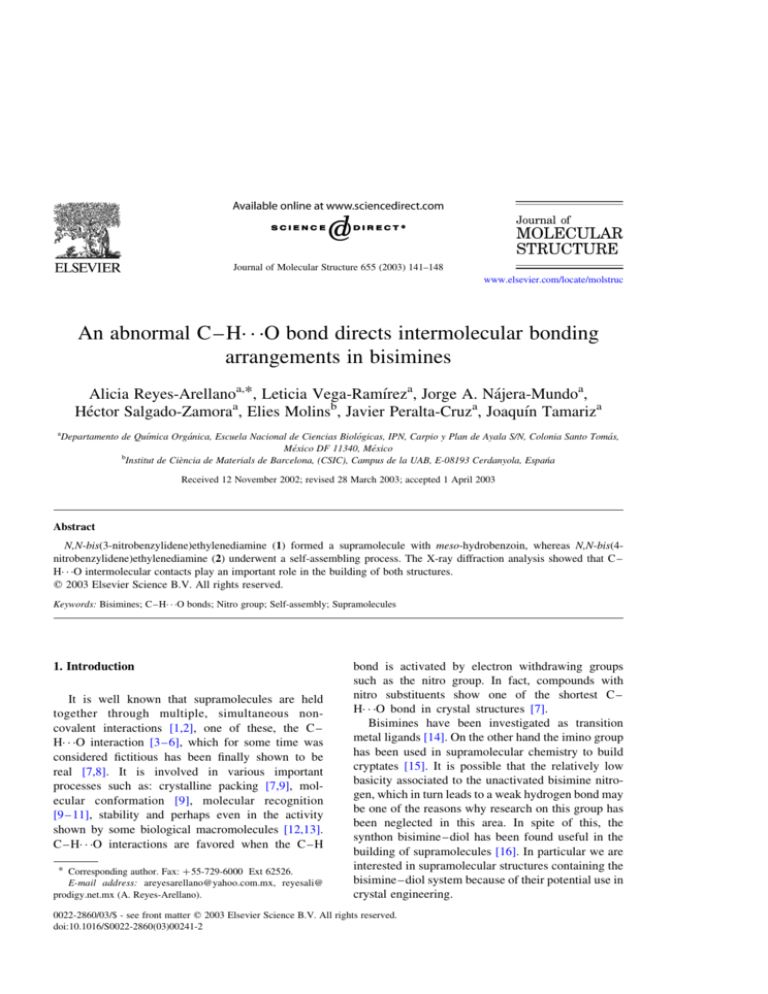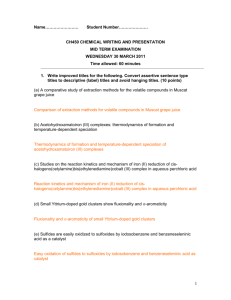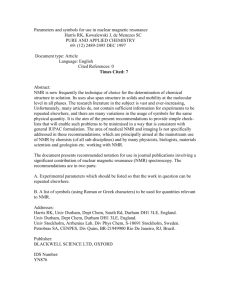
Journal of Molecular Structure 655 (2003) 141–148
www.elsevier.com/locate/molstruc
An abnormal C –H· · ·O bond directs intermolecular bonding
arrangements in bisimines
Alicia Reyes-Arellanoa,*, Leticia Vega-Ramı́reza, Jorge A. Nájera-Mundoa,
Héctor Salgado-Zamoraa, Elies Molinsb, Javier Peralta-Cruza, Joaquı́n Tamariza
a
Departamento de Quı́mica Orgánica, Escuela Nacional de Ciencias Biológicas, IPN, Carpio y Plan de Ayala S/N, Colonia Santo Tomás,
México DF 11340, México
b
Institut de Ciència de Materials de Barcelona, (CSIC), Campus de la UAB, E-08193 Cerdanyola, Espańa
Received 12 November 2002; revised 28 March 2003; accepted 1 April 2003
Abstract
N,N-bis(3-nitrobenzylidene)ethylenediamine (1) formed a supramolecule with meso-hydrobenzoin, whereas N,N-bis(4nitrobenzylidene)ethylenediamine (2) underwent a self-assembling process. The X-ray diffraction analysis showed that C–
H· · ·O intermolecular contacts play an important role in the building of both structures.
q 2003 Elsevier Science B.V. All rights reserved.
Keywords: Bisimines; C –H· · ·O bonds; Nitro group; Self-assembly; Supramolecules
1. Introduction
It is well known that supramolecules are held
together through multiple, simultaneous noncovalent interactions [1,2], one of these, the C –
H· · ·O interaction [3 –6], which for some time was
considered fictitious has been finally shown to be
real [7,8]. It is involved in various important
processes such as: crystalline packing [7,9], molecular conformation [9], molecular recognition
[9 – 11], stability and perhaps even in the activity
shown by some biological macromolecules [12,13].
C – H· · ·O interactions are favored when the C –H
* Corresponding author. Fax: þ 55-729-6000 Ext 62526.
E-mail address: areyesarellano@yahoo.com.mx, reyesali@
prodigy.net.mx (A. Reyes-Arellano).
bond is activated by electron withdrawing groups
such as the nitro group. In fact, compounds with
nitro substituents show one of the shortest C –
H· · ·O bond in crystal structures [7].
Bisimines have been investigated as transition
metal ligands [14]. On the other hand the imino group
has been used in supramolecular chemistry to build
cryptates [15]. It is possible that the relatively low
basicity associated to the unactivated bisimine nitrogen, which in turn leads to a weak hydrogen bond may
be one of the reasons why research on this group has
been neglected in this area. In spite of this, the
synthon bisimine – diol has been found useful in the
building of supramolecules [16]. In particular we are
interested in supramolecular structures containing the
bisimine – diol system because of their potential use in
crystal engineering.
0022-2860/03/$ - see front matter q 2003 Elsevier Science B.V. All rights reserved.
doi:10.1016/S0022-2860(03)00241-2
142
A. Reyes-Arellano et al. / Journal of Molecular Structure 655 (2003) 141–148
We have recently reported [17] the synthesis of
various substituted N,N-bis(benzylidene)ethylenediamines, which were co-crystallized with meso-1,2diphenyl-1,2-ethanediol. It was observed that not all
bisimines formed a complex. Therefore, it seems that
the presence of an aromatic ring in the bisimine
structure (indeed aldimines form complexes but
ketimines do not), coupled to a negligible steric
hindrance are factors (among others) that determine
the complexation process.
As a continuation of our research in this field, an
study of the influence of the nitro group in bisimines was
undertaken. Thus N,N-bis(3-nitrobenzylidene)ethylenediamine (1) and N.N-bis(4-nitrobenzylidene) ethylenediamine (2) were synthesized and treated with
meso-hydrobenzoin. Here we present our results.
2. Experimental
Melting points were determined on an electrothermal melting point apparatus and are uncorrected.
Infrared spectra were recorded on a Perkin– Elmer
599-B spectrophotometer. 1H NMR and 13C NMR
spectra were recorded with a JEOL DELTA-GSX-270
spectrometer equipped with a 5 mm probe. 1H NMR
spectra were recorded at 270.05 MHz (spectral width
2700 Hz, acquisition time 1.516 s, pulse width 458, 32
scans, recycle delay 2 s). 13C NMR spectra were
recorded at 67.80 MHz (spectral width 12224.9 Hz
acquisition time 1.34 s, pulse width 308, 128 scans,
recycle delay 0.8 s). The chemical shifts are referenced to internal (CH3)4Si (d1H ¼ 0, d13C ¼ 0). The
electron ionization (EI) mass spectra (70 eV) were
recorded using a Hewlett Packard HP-5998A spectrometer. The X-ray diffraction analysis of the
supramolecule was obtained on an Enraf – Nonius
CAD-4 diffractometer and the X-ray diffraction
analysis of the N,N-bis(4-nitrobenzylidene) ethylenediamine (2) was performed on an automatic Siemens
diffractometer. Elemental analysis was performed by
M-H-W Laboratories (Phoenix, AZ, USA).
2.1. Synthesis of bisimines
2.1.1. General procedure
To a solution of nitroarylaldehyde in anh. CH2Cl2, an
equimolar solution of ethylenediamine in CH2Cl2 was
added dropwise at ambient temperature. The mixture
was stirred for 30 min, 5 Å molecular sieves (previously
dried at 110 8C during 72 h, cooled and kept for 12 h at
room temperature under N2 atmosphere) were added
and the mixture was intermittently shaken. The mixture
was then filtered, the molecular sieves washed with
CH2Cl2 and the solvent removed under vacuum. The
remaining residue was purified by crystallization and
then dried under high vacuum. All reactions were
performed under a nitrogen atmosphere.
2.2. N,N-bis(3-nitrobenzylidene)ethylenediamine 1
Colorless crystals, mp 158 –160 8C, yield 87.6%
IR (KBr) 3085, 2931, 1647, 1525, 1351, 813 cm21
1
H NMR (DMSOd6 – CDCl3, 2:1) d ¼ 8.49 (s, 2H,
HCyN), 8.41 (s, 2H, H-2), 8.19 (d, 3J ¼ 8.0 Hz, 2H,
H-6), 8.04 (d, 3J ¼ 8.0 Hz, 2H, H-4), 7.61 (t,
3
J ¼ 8.0 Hz, 2H, H-5), 3.70 (s, 4H, CH2CyN). 13C
NMR (DMSOd6 – CDCl3, 2:1) d ¼ 159.9 (CyN),
148.3 (Cipso NO2), 137.5 Cipso CyN) 133.9 (C-2),
129.6 (C-4), 124.8 (C-6), 122.3 (C-5), 61.0 (NyC –
C H2). MS (70 eV) m/z (%) 326 (2) [Mþ], 178 (100)
[M þ – (O 2NC 6H 3 þ HCN)], 163 (33) O 2 NC 6H 4CHyNyCH2], 161 (89) [O2NC6H4CNCH], 117 (74)
[C6H4CHyNyCH2], 90 (82) [C6H4CH þ H].
2.3. N.N-bis-(4-nitrobenzylidene) ethylenediamine 2
Pale yellow crystals, mp 197 – 199 8C, yield
82.0%.
IR (KBr) n ¼ 3100, 3073, 2910, 2855, 1645 CyN),
1602, 1519 y 1339 (NO2), 854 cm21
1
H NMR (DMSO-d6) d ¼ 8.45 (s, 2H, HC ¼ N),
8.05 (AA0 BB0 , 8H,), 4.05 (s, 4H, CH2 – N).
13
C NMR (DMSO-d6) d ¼ 160.0 (CyN), 148.5
(Cipso NO2), 141.0 (CipsoCyN), 128.4 (Cortho
CyN), 123.4 (Cortho NO2), 61.0 (NyC – C H2). MS
(70 eV) m/z (%) ¼ 326 (2) [Mþ], 178 (100) [Mþ –
(O 2 NC 6H 3 þ HCN)], 163 (34) [O 2NC 6H 4CHyNyCH2], 149 (55) [O2NC6H4CNH], 117 (64)
[C6H4CHyNyCH2], 90 (70) [C6H4CH þ H].
2.3.1. Supramolecule I
Equimolar quantities of N,N-bis(3-nitrobenzylidene)ethylenediamine and meso-hydrobenzoin were
dissolved in ethyl acetate and kept in a hexane
atmosphere at room temperature. After 48 h
A. Reyes-Arellano et al. / Journal of Molecular Structure 655 (2003) 141–148
Table 1
Crystallographic data for supramolecule I and self-assembly
structure II from bisimine 2
Formula
Fw
Space group
a (Å)
b (Å)
c (Å)
b (deg)
V (Å3)
Z
T (8K)
l (Å)
rcalcd (g cm23)
m (cm21)
R
Complex between
bisimine 1 and
meso-hydrobenzoin
Self-assembling
structure from bisimine
2
C30H28N4O6
540.56
P21 =c
6.015(2)
30.103(10)
7.4160(10)
94.570(10)
1338.5(7)
2
293(2)
0.7107
1.341
1.07
0.0476
C16H14N4O4
326.31
P21 =n
9.1542(8)
7.2311(4)
11.5083(9)
97.506(8)
755.26(10)
2
293(2)
0.7107
1.435
1
0.0471
143
the crystals formed were collected by filtration and
dried. The title compound I was isolated in 96.0%
yield as colorless crystals, mp 149– 151 8C, IR (KBr)
n ¼ 3201, 2879, 1646 CyN), 1525 y 1346 (NO2), 817,
766 cm21.
1
H NMR (DMSO-d6: CDCl3, 2:1) d ¼ 8.56 (sa,
2H, HCyN), 8.43 ((s, 2H, H-2), 8.25 (dd, 3J ¼ 8.0 Hz,
4
J ¼ 2.2 Hz, 2H, H-6), 8.06 (d, 3J ¼ 8.0 Hz, 2H, H-4),
7.64 (t, 3J ¼ 8.0 Hz, 2H, H-5), 7.21 (m, 10H, C6H5),
4.76 (s, 2H, CHOH), 4.09 (s, 4H, CH2 – N).
13
C NMR (DMSO-d6: CDCl3, 2:1) d ¼ 159.7
(CyN), 148.1 (Cipso NO2), 141.8 (CipsoCHOH),
137.5 (CipsoCyN), 133.7 (C-4), 129.5 (C-5), 127.2
(C-12, C-14).127.06 (C-11, C-15), 126.6 (C-13),
124.6 (C-6), 122.0 (C-2), 77.2 (C HOH), 60.7
(NyC – C H2).
Anal. calcd. for C30H28N4O6: C 66.67, H 5.19, N
10.37, O 17.77; found: C 65.83, H 5.49, N 10.37, O
18.31.
Fig. 1. Single-crystal structure of N,N-bis(3-nitrobenzylidene)ethylenediamine (1) and meso-hydrobenzoin. (a) Monomers, (b) complex.
144
A. Reyes-Arellano et al. / Journal of Molecular Structure 655 (2003) 141–148
2.4. X-ray analysis
Crystal data for supramolecular structure I and self
assembly structure II from bisimine 2 are summarized
in Table 1.
3. Results and discussion
Bisimine 1 was soluble in common solvents, by
contrast bisimine 2 was insoluble in CH2Cl2, water,
also insoluble in different mixtures of hexane-EtOAc,
hardly soluble in EtOAc and sparingly soluble in
acetone, DMSO and DMF. Its melting point was
unusually high, 197 –199 8C [cf. 51 –52 8C for the
N,N-bis(benzylidene)ethylenediamine) unsubstituted
bisimine] [16].
The co-crystallization of nitroarylbisimines 1 and 2
with meso-hydrobenzoin was attempted, following the
reported procedure [17]. The isolated crystalline
structure from the reaction with meta-nitrosubstituted
bisimine 1 indicated the formation of a supramolecule
[18] (Fig. 1). In the IR spectrum, this complex showed
the O – H absorption shifted to a lower frequency
(3201 cm21) as shown by analogous supramolecules,
for instance the complex obtained with an unsubstituted
bisimine [16] (3181 cm21) or the complex formed with
the 4-methoxy bisimine [17] (3169 cm21).
It is interesting to observe, how the molecular
recognition process involved in the supramolecular
synthesis led the bisimine to naturally adopt a s-trans
geometry. Fig. 2. A geometry, which has been
observed in supramolecules obtained from bisimines
and meso-hydrobenzoin or hydroquinone [16,17,19].
The s-cis geometry has not been observed in this type
of supramolecules. To the best of our knowledge the
s-cis geometry is the type of conformation adopted by
bisimines in coordination complexes with transition
metals [14] (Fig. 3).
The intermolecular interactions [20] which
resulted in the supramolecule are: a hydrogen bond,
C – H· · ·O contacts [3 – 5], C – H· · ·p[21,22] and p –p
interactions [23,24] (Table 2). Bond angles and
distances found in these structures are in good
agreement with those reported in the literature [3].
An interesting observation was the fact that one of
the hydrogen participating in the C –H· · ·O bonding is
ortho to the imino group, i. e. the less acidic hydrogen.
Fig. 2. s-Trans geometry adopted by bisimines in a supramolecular
complex.
An effective activation of the C4 – (H) proton, ortho to
the –CyN and para to the nitro group may be
operating. Another force involved emerges as a
cooperative effect from the hydroxyl group, a
donor – acceptor proton group.
Complex presence was supported by crystal
formation, melting point (within a range of three
degrees) and the 1:1 ratio of monomers determined by
Fig. 3. s-Cis geometry of bisimines in a transition metal complex.
A. Reyes-Arellano et al. / Journal of Molecular Structure 655 (2003) 141–148
145
Table 2
Intermolecular interactions found in the complex between the bisimine 1 and meso-hydrobenzoin
Interaction
Atoms or rings involved
Distance (Å)
Angle (8)
Hydrogen bond
O(3)–H· · ·N(2)yC
C –H· · ·O
C(8)–H· · ·O(3)
C(7)yN(2)· · ·H(3)
O–H· · ·N ¼ 134.60
C(8)–H· · ·O(3) ¼ 153.04
C–H· · ·p
C(4)–H· · ·O(3)
C(4)–H· · ·Cg(2)
O· · ·(N ¼ 2.83
O–H· · ·N 2.03
C· · ·O ¼ 3.20
H· · ·O ¼ 2.83
H· · ·O ¼ 2.78
H· · ·Cg ¼ 3.19
C· · ·Cg ¼ 3.76
H· · ·Cg ¼ 3.08
C· · ·Cg ¼ 3.78
Cg(1)· · ·Cg(2) ¼ 5.85, Cg(1)· · ·
perpendicular distance from
Cg(2) to bisimine plane ¼ 4.76
C(7)–H· · ·Cg(2)
p –p
a
Bisimine and meso-hydrobenzoin
C(4)–H· · ·O ¼ 158.51
C –H· · ·Cg ¼ 121.42
C –H· · ·Cg ¼ 133.20
70.25a
Cg(1) Centroid of the bisimine ring. Cg(2) Centroid of the meso-hydrobenzoin ring.
Dihedral angle between the plane of the two rings.
the 1H NMR spectrum. The X-ray diffraction on the
monocrystal further confirmed the structure.
On the other hand, under the same conditions the cocrystallization of bisimine 2 with meso-hydrobenzoin
did not proceed. Other experimental conditions
included the treatment of equimolar quantities of
reactants in different solvents and at different temperatures for instance in ethyl acetate temperature was
varied from 2 10 to 40 8C; in acetone from 2 10 to
15 8C, higher temperatures in the latter solvent were
avoided to prevent a transimine reaction. In DMSO and
DMF the reactants were kept at low temperature
(2 3 8C). No reaction was observed and in some cases
(acetone, ethyl acetate) crystals separated from the
reaction mixture gave a wide range melting point and
their 1H NMR showed marked inconsistent monomers
ratios. However, after 90 days in DMF, crystals were
formed, separated and analysed. From the spectroscopic data, it was clear that complexation had not taken
place, the strong electron withdrawing effect exerted by
the p-nitro substituent, which leaves a poor electron
density on the imino group may be responsible.
However, the X-ray study clearly indicates that
bisimine 2 undergoes a self-assembling process (structure II) through C –H· · ·O bonds (Figs. 4 and 5, Table 3)
formed between the C(3) – H (meta to the nitro group) of
a bisimine aromatic ring and the nitro O of another
bisimine molecule. Indeed it is intriguing that the
electron-withdrawing effect is directed by the imino,
rather than by the stronger electron attractor nitro group,
as a result the formation of the self-assembling array,
with the less acidic hydrogen participating in the C –
H· · ·O bond is in sharp contrast to the generally C –
H· · ·O system observed [3].
A face to face stacked geometry may be considered
for the self-array molecule obtained from 2 as a
consequence of the p –p interaction observed and
could be explained by the presence of stronglypolarizing nitro groups, which permit the formation of
p-deficient atoms in the aromatic ring and according
to Hunter [23] the interaction between two p-deficient
atoms is favourable. It can be seen from Fig. 3 that the
self-assembly array led to the formation of channels
and it seems that such arrangement preclude supramolecule formation. However, crystal engineering
might take advantage of these channels.
Table 3
Intermolecular interactions found in the X-ray diffraction of N,Nbis(4-nitrobenzylidene)ethylenediamine, 2
Interaction Atoms or ring involved Distance Angle
(Å)
(8)
C–H· · ·Oa
p–pb
C(3)–H· · ·O(11)
C(3)· · ·O
Cg· · ·Cg
2.41
3.22
3.70
O· · ·H–C ¼ 145.9
Cg· · ·Cg ¼ 74.6c
a
Distances C–H· · ·O . 3.0 , 4.0 Å and angle u ¼ 150–1608
are common [3].
b
Distances between the centroids (Cg· · ·Cg) , 6 Å are
significant.
c
Angle shown in Fig. 3.
146
A. Reyes-Arellano et al. / Journal of Molecular Structure 655 (2003) 141–148
Fig. 4. Single-crystal structure of the self-assembling structure II.
Fig. 5. Network of N,N-bis(4-nitrobenzylidene)ethylenediamine showing the p –p interaction.
A. Reyes-Arellano et al. / Journal of Molecular Structure 655 (2003) 141–148
147
Table 4
Some selected C –H· · ·O distances (Å) related to the self assembling structure of bisimine 2
Molecule C–H donor
3,4-methylenedioxycinnamic
acid
3,4-(methylenedioxy)phenylpro-piolic
acid
3,4-methylenedioxy-cinnamic
acid
CH2Cl2
(CH3)2SO
N,N-bis(4-nitrobenzylidene)
etylenediamine
a
b
c
d
H-donor group
Phenyl
Phenyl
CHyCH
HCH
H2CH
C(3)–H
(phenyl)
Molecule C–H acceptor
3,4-methylenedioxycinnamic
acida
3,4-(methylenedioxy)
phenylpropiolic acida
3,4-methylenedioxycinnamic acida
NO2b,c
NO2b,c
N,N-bis(4-nitrobenzylidene)
etylenediaminea
H-acceptor group
Distance (Å)
C –H· · ·O
Reference
C· · ·O
H· · ·O
COOH
3.37
2.88
COOH
3.36
CH2 –O–
3.47
2.48
[9]
NO2
NO2
NO2
3.32d
3.45d
3.22
2.41d
2.57d
2.41
[26]
[26]
[9]
[3]
Autoorganization.
Complexation.
Different NO2 acceptors.
Mean C· · ·O and H· · ·O values.
Studies involving the C – H· · ·O length have shown
that different behaviour is observed for chemically
different C –H types. However, a relationship between
the donor C –H acidity and bond length has been
established, such that the stronger donor C – H acidity
is associated with a shorter bond distance [6].
Moreover the average C – H· · ·O distances have been
reasonably well correlated with conventional pKa
values (DMSO) in 551 structures, thus giving rise to a
useful crystallographic scale [25].
Some selected examples of C –H acidic donors
related with the auto-organized structure II are given in
Table 4. If the bond distances in this table are compared
with those C –H· · ·O bond lengths measured from II,
then it is possible to accommodate this self-assembly in
the following acidity order.
Phenyl
of
N,N-bis(4-nitrobenzylidene)
ethylenediamine . phenyl of 3,4-(methylendioxy)phenylpropiolic acid . phenyl of 3,4-methylendioxycinnamic acid . CH2Cl2 . DMSO . CHyCH
whereas N,N-bis(4-nitrobenzylidene)ethylenediamine
2 underwent a self-assembling process. Participation
in the C – H· · ·O bonding of the less acidic hydrogen,
ortho to the imino group in both complexes was
observed.
In both cases, the X-ray diffraction analysis
provides evidence that a cooperation amongst several
intermolecular bonds does exist. It is obvious that
C– H· · ·O bonds are not the only interactions to favour
the complex formation but do contribute very
importantly.
p – p Interactions coupled to van der Waals attractive forces allowed the formation of a self-assembled
structure from bisimine 2, C – H· · ·O bonds are weak but
numerous and may explain the complexation inability
of bisimine 2 with meso-hydroxybenzoin. It is important to remark that while the C – H· · ·O interactions
disfavoured supramolecular formation did favour the
self-assembly process.
Acknowledgements
4. Conclusions
N,N-bis(3-nitrobenzylidene)ethylenediamine 1
formed a supramolecule with meso-hydrobenzoin,
We thank Dr Hugo Jiménez Vázquez for taking the
X-ray diffraction of N,N-bis(4-nitrobenzylidene)ethylenediamine. A. R. acknowledges Conacyt (México)
148
A. Reyes-Arellano et al. / Journal of Molecular Structure 655 (2003) 141–148
for financial support through grant 26425N and
IPN/CGEPI through grant 20020731.
References
[1] J.-M. Lehn, Angew. Chem. Int. Ed. Engl. 27 (1988) 89.
[2] J.-M. Lehn, Supramolecular Chemistry, Concepts and perspectives, VCH Verlaggesellschaft mbH, Weinheim, Bundesrepublik Deutschland, 1995.
[3] G.R. Desiraju, Acc. Chem. Res. 24 (1991) 290–296.
[4] G.R. Desiraju, Perspectives in Supramolecular Chemistry, vol.
2, Wiley, New York, USA, 1995.
[5] G.R. Desiraju, Angew. Chem. Int. Ed. Engl. 34 (1995)
2311–2327.
[6] G.R. Desiraju, T.D. Steiner, The Weak Hydrogen Bond: in
Structural Chemistry and Biology, Oxford University Press,
UK, 2001.
[7] T. Steiner, Chem. Commun. (1997) 727–734.
[8] E. Espinosa, C. Lecomte, E. Molins, Chem. Phys. Lett. 300
(1999) 745–748.
[9] J.A.R.P. Sarma, G.R. Desiraju, Acc. Chem. Res. 19 (1986)
222–228. Z. Berkovich-Yellin, L. Leiserowitz, Acta Crystallogr., Sect. B 40 (1984) 159.
[10] P.R. Ashton, A.N. Collins, M.C.T. Fyfe, S. Menzer, J.F.
Stoddart, D.J. Williams, Angew. Chem. Int. Ed. Engl. 36
(1997) 735–739.
[11] L.J.W. Shimon, M. Vaida, L. Addadi, M. Lahav, L.
Leiserowitz, J. Am. Chem. Soc. 112 (1990) 6215.
[12] Z.S. Derewenda, L. Lee, U. Derewenda, J. Mol. Biol. 252
(1995) 248.
[13] M.C. Wahl, S.T. Rao, M. Sundaralingam, Nature Struct. Biol. 3
(1996) 24.
[14] M.A. Paz-Sandoval, M.E. Domı́nguez-Durán, C. Pazos-Mayen,
A. Araiza-Castolo, M. De J, R. Rosales-Hoz, J. Contreras,
Organomet. Chem. 492 (1995) 1–9.
[15] J. Jazwinski, J.-M. Lehn, D. Lilienbaum, R. Ziessel, J. Guilhem,
C. Pascard, J. Chem. Soc. Chem. Commun. (1987) 1691.
[16] R. Reyes-Arellano, R. Bose, I. Steller, R. Sustmann, Struct.
Chem. 6 (1995) 391.
[17] A. Reyes, J. Nájera, R. Mendoza, E. Molins, I. Grau, E.
Espinosa, H. Salgado, J. Tamariz, M. Soriano, K. Pannerselvam, Supramol. Chem. 11 (1999) 17–24.
[18] Supramolecules ‘are composed of two or more molecules
or ions held together in a unique structural relationship by
electrostatics forces other than those of full covalent
bonds’J.W. Steed, J.L. Atwood, Supramolecular Chemistry,
Wiley, Baffins Lane, Chichester, UK, 2000, pp. 3.
[19] K. Pannerselvam, M. Soriano-Garcı́a, A. Reyes-Arellano, J.
Tamariz-Mascarúa, R.I. Mendoza-Sánchez, Acta Crystallogr.
C52 (1996) 3098–3100. K. Pannerselvam, M. Soriano-Garcı́a,
A. Reyes-Arellano, J. Tamariz-Mascarúa, R.I. MendozaSánchez, Anal. Sci. 12 (1996) 823–824.
[20] The intermolecular interactions were calculated by the Platon
Programme A.L. Speck, Platon—a Multipurpose Crystallographic Tool, Utrecht University, Utrecht, The Netherlands,
1998.
[21] M. Nishio, M. Hirota, Tetrahedron 23 (1989) 7201–7245.
[22] M. Nishio, Y. Umezawa, M. Hirota, Y. Takeuchi, Tetrahedron
51 (1995) 8665.
[23] C.A. Hunter, J.K.M. Sanders, J. Am. Chem. Soc. 112 (1990)
5525–5534.
[24] C.A. Hunter, Chem. Soc. Rev. (1994) 101–109.
[25] V.R. Pedireddi, G.R. Desiraju, J. Chem. Soc. Chem. Commun.
(1992) 988 –990.
[26] T. Steiner, J. Chem. Soc. Chem. Commun. (1994) 2341–2342.









